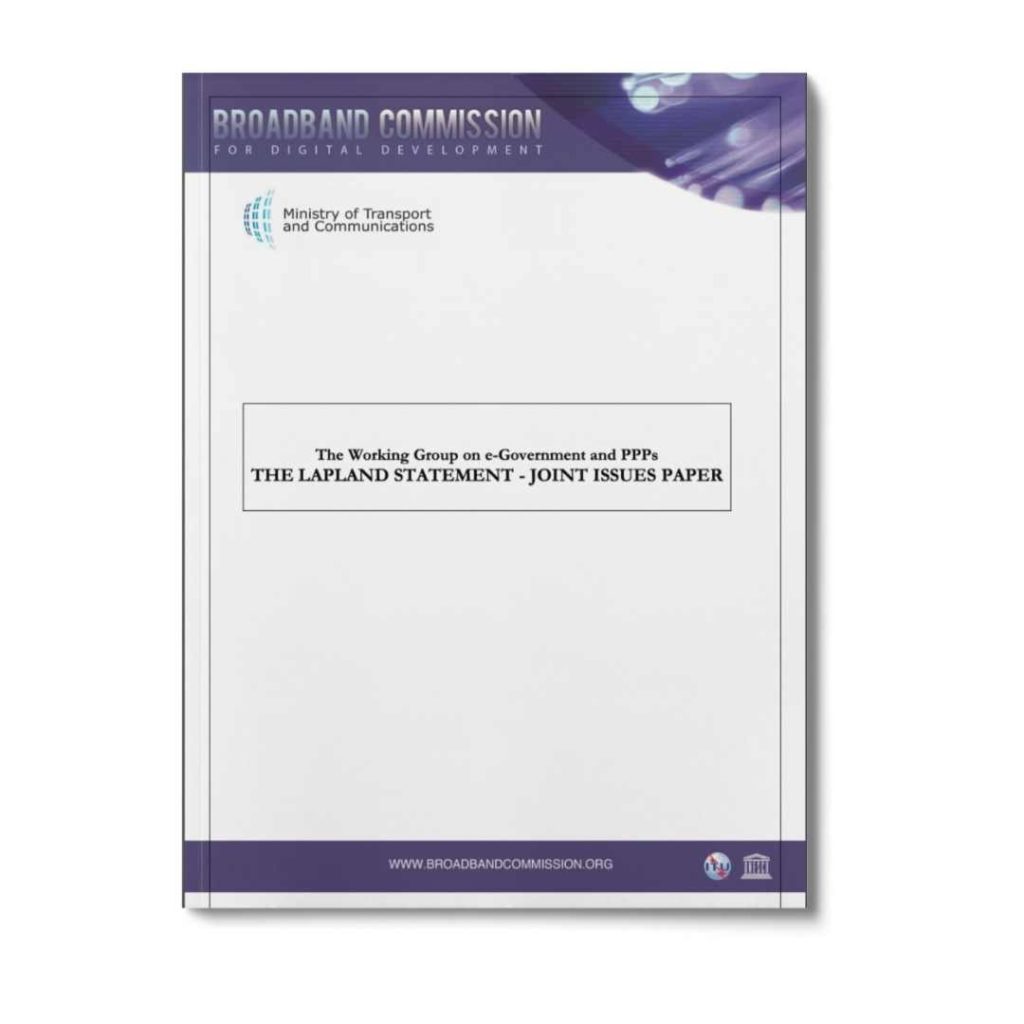What can be done to facilitate
e-Government development?
Chaired by Ms. Suvi Linden, ITU Special Envoy to the Broadband Commission and Former Minister of Telecommunications and Transport of Finland, the Broadband Commission for Sustainable Development’s Working Group on e-Government and Public-Private Partnerships (PPPs) was established in 2012 to highlight the opportunities associated with e-Government and PPPs in the future development of broadband. The 2012 Working Group produced The Lapland Statement, a joint issues paper, to identify the components of an enabling environment for E-Government applications to network infrastructure, as well as stakeholders’ roles in realizing these environments.
Setting the Stage
Background Overview
What is e-Government?
E-Government is the application of information-communication technologies (ICTs) to government functions and procedures, as a means of increasing efficiency, transparency and citizen participation. Increasingly, governments are using information-communication technologies (ICTs) to provide services between government agencies and citizens, businesses, employees and non-governmental agencies.
What can financing e-Government look like?
At the time of the Working Group’s research, e-Government initiatives in developing countries had not only struggled with a lack of financial resources and incentive design, but also with restricted skills and capacity within the governments.
- A top-down approach matched with grassroots involvement and ownership is necessary for constructing a national digital economy.
An increasing number of initiatives are being employed to improve the delivery of public services to the people, and to tap the potential synergy from the interaction between new technologies, an educated population and an enabling environment for the attainment of knowledge-based economies.
Public-private partnerships (PPPs) are one way to finance the uptake of infrastructure and services. In the several decades prior to the 2012 Working Group, governments turned increasingly to PPPs as one means of financing and maintaining infrastructure and providing public services in the face of budgetary challenges. PPPs help to bridge gaps in quality, speed, and efficiency of services delivered by the public sector and have a holistic approach in developing the broadband system.
The Way Forward
Conclusions and Recommendations
According to the Working Group’s 2012 Joint Issues Paper — The Lapland Statement — the key elements which form the optimal enabling environment in a country to develop ICT services are: connectivity, affordability, availability and security.
Sufficient financial and human resource mobilization to realize E-Government potential requires local, and international, as well as multi-stakeholder contribution, and Governments should play a role in creating useful e-Services and stimulate user-friendly e-content, as good governance is also essential in building a good environment for development.
The Working Group’s Joint Issues Paper is based on the process approach for E-Government services, which includes:
- Participation of Beneficiaries in the Design and/or Implementation of the Project
- Flexibility and Improvisation in the Implementation of the Project
- Learning in Order to Improve the Implementation of the Project
- Utilizing and Building Local Capacities Including Those of Local Institutions
- Competent Leadership of the Project That is Able to Promote the Other Four Elements
The larger strategic recommendations of this Working Group’s report are:
1. The Broadband Commission has established an online database open to all which features different case studies, best practices, reports and policy recommendations. The Working Group encourages different stakeholders and governments to use the Broadband Commission website tool.
2. Many international organisations, such as the OECD, have extensive experience and valuable information on good policy practices on broadband. This is available to all countries, who are encouraged to use this expertise and be more associated with the OECD work.
3. Public and private international financial institutions are encouraged to contribute to the funding of broadband investments.
4. It is recommended to improve definitions along with relevant databases and measurement of broadband penetration, usage, coverage, prices, speeds and services taking into account the local elements.
5. To get a sustainable base for dynamically evolving e-Government services certain principles, enablers and starting points should be established. These include for example a common framework for network technology, standards, scalable business models, target setting and measuring of results.
6. E-Government service roll-outs should start from those that are often needed by many locally (to create the e-habit) and that also improve efficiency and create value for the public sector.
7. The public-private partnership model should aim at both sectors using the same solutions (to create economy of reuse, economy of scale and economy of scope) and making it possible for citizens to use the same tools, creating economy of repetition and economy of trust.
8. The basic enabler for e-Government services is network reach, affordability and sufficient capacity. This growth is driven by parallel progress in several layers. The most important drivers are the services and content – created in public-private co- operation in an “e-Agora” – driven by the holistic needs of citizens. These are enabled by cloud services connected to increasingly mobile and dynamically developing mobile devices.
The Working Group Model
Composition and Activities

Ms. Suvi Linden
Former Minister of Telecommunication and Transport, Finland, and ITU Special Envoy to the Broadband Commission
WG-EGov held its inaugural meeting in Levi, Finland, on 5 March 2011.
Focus Area
Outcome Documents
Co-Chairs
Ms. Suvi Linden
Former Minister of Telecommunication and Transport, Finland, and ITU Special Envoy to the Broadband Commission
Broadband Advocacy Targets
SDGs





